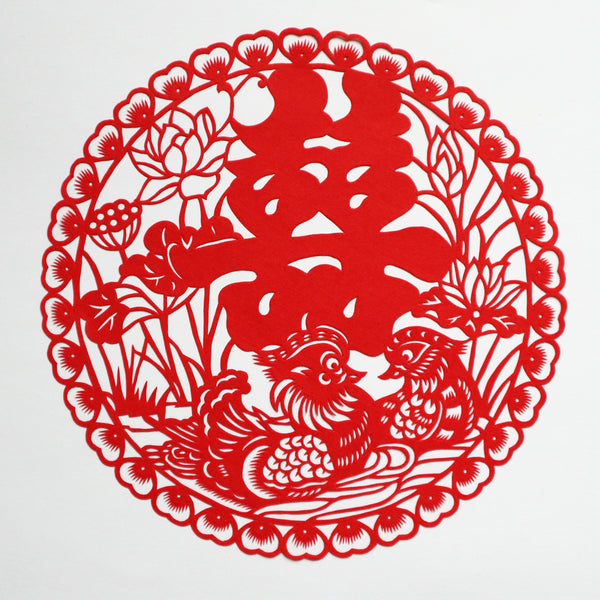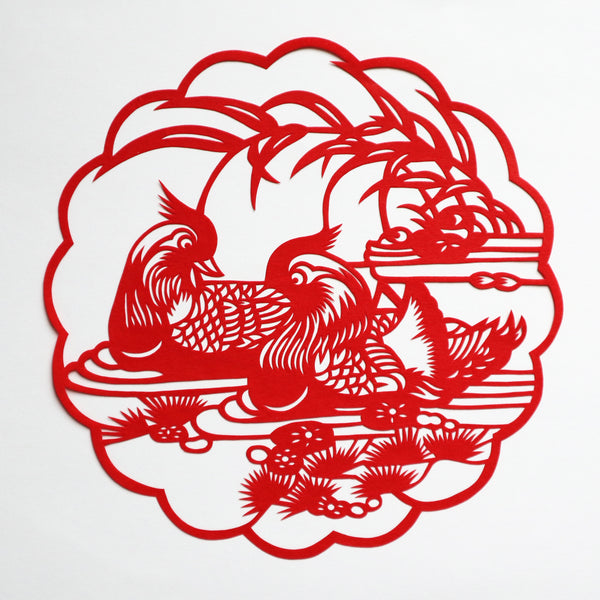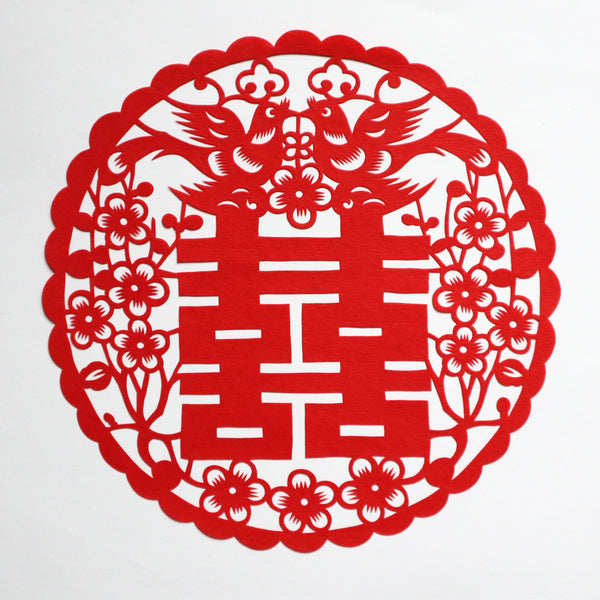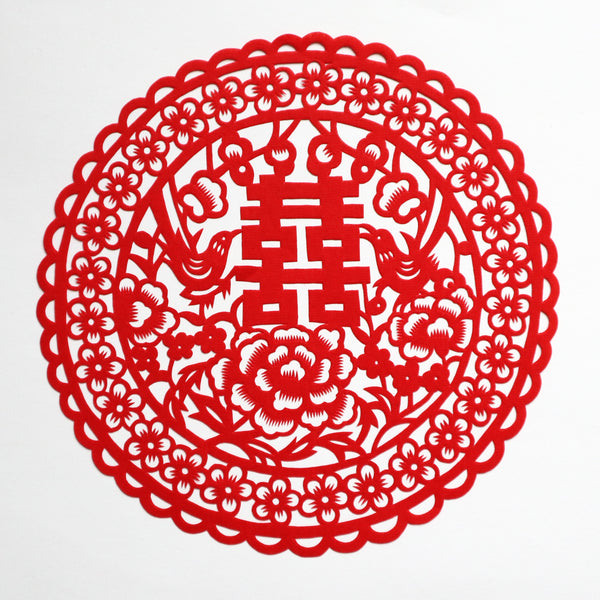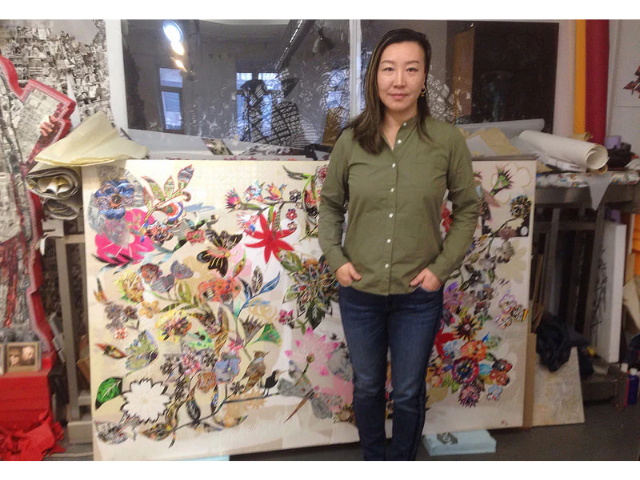
Artist-in-Residence Xin Song Sparkles: Her Modern Take on an Ancient Chinese Art
While you may be familiar with the traditional folk art of Chinese papercutting, you might not have seen it like this before.
That’s just one reason we’re so excited about our newest artist-in-residence, Xin Song, and her exhibition, Sparkling. Ms. Song takes the farmers’ folk art to a whole new level, using her own photography, magazines, Mylar, rice and other papers, and often creating large-scale installations in public spaces like Grand Central Station and the Flatiron Building. Her diverse themes range from venerable flower motifs and landscape studies to urban scenes that reflect her longtime residence in New York.
She has had numerous public commissions, multiple awards and grants, and national and international exhibitions, including the Noyes Museum of Art of New Jersey, Staten Island Museum, Musée du Louvre, and National Art Museum of China. She has also been a lecturer at Hunter College, the Fashion Institute of Technology, Stony Brook University, and elsewhere.
We had the chance to talk to Ms. Song about growing up as an artsy kid in China’s Silicon Valley, the importance of seeing differently, and the first time she picked up a pair of scissors and “just started cutting.”
Where did you grow up?
I was born and grew up in Beijing. It was kind of like Silicon Valley. The top technology people are there. All the kids studied science and did really well in school. I was the one in the middle. I wasn’t a top student. My classmates’ parents all felt like, “You need to get a 100% on every test!” I’m not like that.
Were you always interested in art?
I was. I drew well but I mostly did it for fun. Still, my mom sent me to a children’s art program at the Children’s Palace [a public facility for children's extracurricular activities]. I started that in middle school.
It was my first teacher at the Children’s Palace who encouraged me to study art. I said, “What? Art?” The people in the area just studied science. In my grade I was the only one who studied art.
Did you continue studying art after the Children’s Palace?
Yes, I went to a special high school for art. Then Central Academy of Fine Arts where I studied folk arts.
I read in an interview that one day at 18 you picked up a pair of scissors and just started cutting paper. Thus beginning your journey with the art of papercutting. Was that just by chance?
Yes, by chance! In elementary school, all kids studied traditional papercutting so I was already familiar with it. I had traveled to the countryside and seen farmers cutting paper and decorating windows.
Did you immediately know that papercutting was an art form you wanted to pursue seriously?
No, I didn’t know. I just started cutting. My friend said, “How did you do that?” I said, “I don’t know!” My friend suggested that I see papercutting in different regions in China. I went to the library in the Beijing Public Library and looked for references for folk art. It opened my eyes to a big field. It’s all farmers, nothing modern. All craft work.
That summer I cut around 200 papercuts. Later on that work was published in a book. A collection called Modern Paper Cuts.
So you had that book published when you were just 18?
Yeah!
Wow!
I know! When you’re young, you’re not scared. You just do what you want to do.
How did your parents react to your wanting to be an artist?
Forget about it! [Laughs] Art as a hobby is good but not as a career. But later on they became supportive.
After you became successful?
[Laughs] Yeah! Eventually they understood seeing how serious I was, and then they were very supportive.
When did you come to the U.S.?
The year 2000.
Did you experience culture shock when you first came here?
Definitely. Everything was so new, so different. I grew up in a big city, but New York is more blended. There are more cultures. I think that inspired me a lot. Seeing different kinds of people everywhere. Right next to you. With your own city, that’s where you grew up. You’re used to it. You don’t see as much. When you move to a new place, everything — architecture, people’s behavior, the way they talk — all of it is so interesting to me.
How do you come up with an idea? Do you do a lot of planning before creating the work?
It depends on the project. Say for public art, I go to the place a lot and do a lot of research. Then I come up with an idea. I feel for public art, that space, I’m installing my art for them. My work must have a conversation with that space.
How did you come up with that idea of performing papercutting?
I was having an exhibition at Cleveland University. I was in the gallery space, creating something, just cutting. The curator, Dr. Qian, was passing by and he sees my cutting. He says, “Oh my god, this is great! That’s amazing amazing to see!” And later on, I thought maybe I can do a live performance of papercutting. I started doing that two years ago.
What do you find inspiring?
I have a lot of inspiration. From music, movies, books, other people, art. The grandpa or grandma I see in Chinatown. If you see, you’ll be inspired. Everything and anything can be inspiring.
What advice do you have for someone interested in pursuing art?
Keep working and chasing your dreams. There’s no other way. That’s all. Nothing fancy.
Sparkling will be on display in our TriBeCa mezzanine gallery from Feb. 18 through through March 24, 2018. To learn more about Ms. Song, visit her website or follow her on Instagram.
